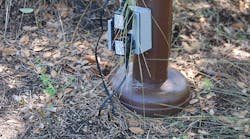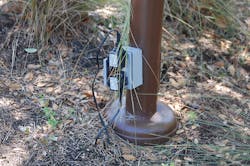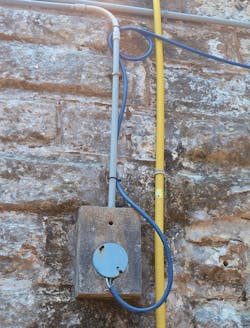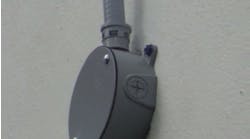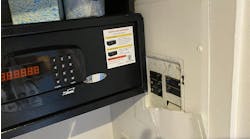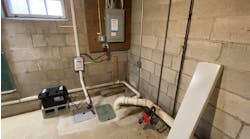All references are based on the 2017 edition of the NEC.
Exposed to the Elements
This installation is a classic example of why Sec. 406.9(B)(1) requires receptacles in wet locations to be installed in enclosures that provide a weatherproof enclosure, whether the attachment plug cap is inserted or not. The type of cover installed in this photo does not provide a weatherproof in-use type of enclosure. This cover provides a weatherproof enclosure only when it is closed. This is the wrong type of cover to use for this application. “Bubble covers” or “accordion covers” can provide the weatherproof in-use type of enclosure and are required for 15A and 20A, 125V and 250V receptacles installed in a wet location. Any type of outlet box hood installed for this purpose is required to be listed and identified as “extra-duty.” With this cover open, rain and moisture can cause significant damage to the GFCI receptacle installed in the box. The electronics can fail, which would create a shock hazard if the GFCI protection is not working properly. I’m not sure what these power supplies are providing power to. It may be landscape lighting, but I am not positive. Hopefully, those flexible cords are rated for direct burial.
Makes Me Feel Blue
Using PVC conduit as the support for this flexible cord has me feeling blue. Section 352.12(B) makes it clear that PVC conduit should not be used for supporting luminaires or other equipment, including this flexible cord. In similar fashion, Sec. 300.11(C) prohibits raceways from supporting raceways, cables, or other non-electric equipment unless the raceway is identified as a means of support. This flexible cord may be providing temporary power, which is permitted by Sec. 590.4(C). However, nothing in Art. 590 modifies the rules prohibiting PVC conduit from being used as a supporting means. For temporary use, in accordance with Sec. 590.4(J), flexible cord should be secured directly to the structure instead of the PVC conduit. Installing the orange ENT outside also has me feeling blue. Section 362.12(7) prohibits ENT from being installed in locations where it is exposed to the direct rays of the sun unless the ENT is identified as being sunlight-resistant. If this ENT is rated as being sunlight-resistant, then it may need a few more support clips too, since Sec. 362.30(A) requires ENT to be securely fastened at intervals no greater than 3 ft.
